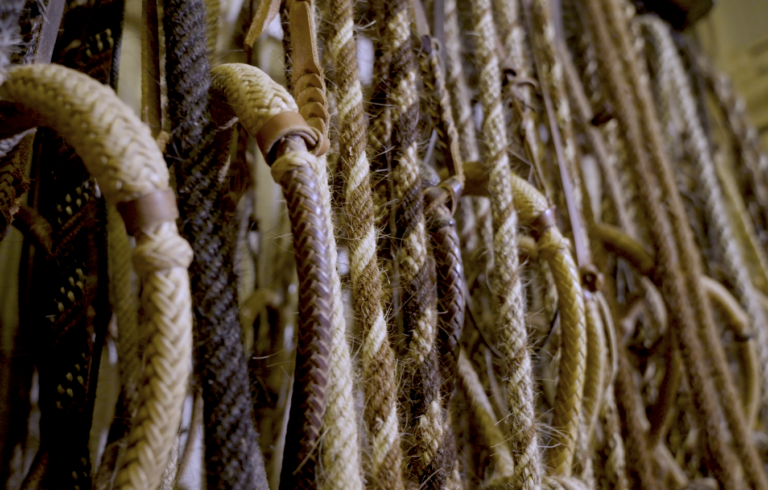This article is part of our Saddle Up With Comfort Awareness Campaign, brought to you by 5 Star Equine Products.
Your saddle rigging affects how you sit, how well your saddle fits your horse, and how well you’re able to perform the equine event of your choice. Variations in rigging styles give you options you may not even know you have. Options that go beyond rigging’s primary function of keeping the saddle on your horse. By learning to evaluate variations with an educated eye, you can determine whether your existing rigging is right for you. Then, select the best rigging the next time you buy a saddle.
Tree Rigging Vs. In-Skirt
You get the most strength and greatest durability with the tree rigging (also called D-type rigging), because its fittings are attached directly to the tree. The strongest, most durable part of the saddle. The system works this way: For each side of the saddle, a section of leather is doubled around a D-shaped cinch ring, then nailed or screwed to the tree just under the swell. Tree rigging’s biggest drawback, bulk under your thighs (which can impede contact with your horse), comes from this heavy-duty construction.
With in-skirt rigging, the left and right front cinch rings are screwed or riveted to the bottom of the less-sturdy skirt, not to the tree. The setup is reinforced with a jigsaw-shaped section of leather that is layered over the skirt fronts (from the swells to the cinch ring), then screwed onto the tree. This system’s advantage is that with cinch rings placed at the bottom of the skirt, not below the swells. And, when you have just one layer of reinforcement leather, you have less bulk under your thighs, allowing for closer contact with your horse.

Single Rigging Vs. Double Rigging
A single-rigged saddle provides only for attachment of a front cinch. A double-rigged saddle adds a place for attachment of an optional back cinch. A back cinch helps anchor a saddle during rigorous riding. Ropers need one to keep the cantle down, and trail riders often find it helps keep the saddle from sliding forward while going downhill. The double-rigged option is especially called for when the front cinch is in the full (farthest-forward) position, because without it, the back of the saddle is likely to rise.

Front Ring Position
Positions between these two, such as 15/16, 7/8, 3/4, and 5/8, are referred to as fractionals.
The 7/8 position, which sets the cinch an inch farther back, literally gives a horse more elbow room. Lack of interference with motion makes this position popular with reiners, trail riders, and barrel racers. Equitation riders also like the 7/8 position for its ability to keep the saddle from slipping back; this allows them to maintain a lower-leg position that’s below the hips.

The 3/4 position, which sets the cinch 1-1/2 inches back from the 7/8 position, puts an even pull on the front and back of the saddle. Thus, anchoring the saddle below the rider’s weight, and preventing it from sliding forward. It’s considered ideal for the high action runs, turn, and stops in working cow horse events. It’s also preferred by trail riders who tackle extremely steep terrain.
Centerfire and 5/8 positions place the cinch back toward the middle of the horse’s barrel. Too far back to keep the saddle on for today’s types of riding. Therefore, people consider them “old style” and no longer find them practical. So, cowboys of yore simply used these cinch positions to keep their saddles on, especially before the development of double rigging.Yesterday’s small-backed cow ponies did not have much surface to hold a saddle. So, cowboys of yore used these cinch positions to keep their saddles on, especially before double rigging was developed.
The 15/16 position places the cinch just a half-inch forward of 7/8, a custom feature requested only by pros who can feel the difference.
Which Rigging Is for You?
To choose your saddle rigging, follow these three steps.
- Determine the rigging style best suited to your event or riding style.
- Consider your horse’s conformation. If you horse has high withers, a full-rigged saddle will tent or slide back. So, a saddle rigged at the 7/8 position, or farther back, is better. On the other hand, a mutton-withered horse that’s built downhill requires a full-double rigging to prevent the saddle from sliding forward.
- Check for quality. You should look for cinch ring hardware made out of stainless steel, bronze, or brass. Stay away from aluminum and chrome plate, which corrode or rust with use. (Quality hardware is a hallmark of well-made rigging and also of a high-grade saddle.) Check the leather. It should be soft and supple, not dry and cracking. Pull hard on the cinch ring to determine the firmness of its attachment. Reputable manufacturers offer warranties on the rigging.
After you buy your saddle, check the rigging for wear and tear before each ride. If the leather creaks when you pull on it; has cracks, tears, or loose rivets; or doesn’t look “right” for any other reason, take your saddle to a reputable repair shop. You’re only as safe as your rigging is solid.







